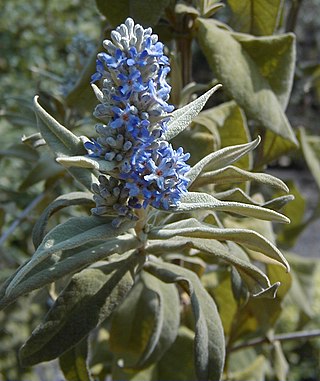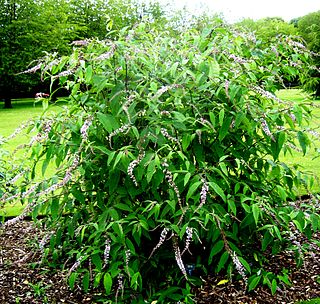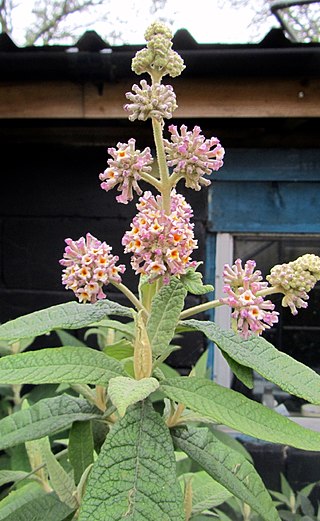
Buddleja saligna, the false olive or bastard olive, is native to South Africa, where it has a wide distribution, and Zimbabwe. It occurs most often in ravines and against outcrops, and is distributed from coastal elevations to the central plateau at elevations of < 2000 m. The species was first described and named by Willdenow in 1809.

Buddleja salviifolia, common names sage bush and sagewood, is endemic to much of southern and eastern Africa, from Kenya and Angola south, where it grows on rocky hillsides, along forest margins and watercourses. The species was described and named by Lamarck in 1792.

Buddleja sterniana was a species sunk as Buddleja crispa by Leeuwenberg in 1979, and treated as such in the subsequent Flora of China. However, the plant remains widely known by its former epithet in horticulture.

Buddleja albiflora is a deciduous shrub native to the mountains of central China, where it grows on shrub-clad slopes at altitudes of between 1,000 and 2,000 m. Named rather carelessly by Hemsley, the species was discovered by Henry, and introduced to western cultivation by Wilson in 1900.

Buddleja auriculata is an evergreen shrub endemic to Zimbabwe, Mozambique, and South Africa, growing in montane fields and thickets at elevations of 600–2,000 m. First collected by W. J. Burchell in 1813, and named by Bentham, the date of its introduction to western cultivation is not known, however it was accorded the Royal Horticultural Society Award of Merit in 1923.

Buddleja agathosma is a deciduous shrub endemic to western Yunnan, China. Originally identified as B. agathosma by Ludwig Diels, it was sunk as Buddleja crispa by Leeuwenberg in 1979, and treated as such in the subsequent Flora of China published in 1996. However, the shrub remains widely known by its former epithet in horticulture.

Buddleja asiatica is a somewhat tender deciduous shrub native to a vast area of the East Indies, including India, Nepal, Bangladesh, China, Taiwan, Burma, Thailand, Laos, Cambodia, Vietnam, Malaysia, New Guinea, and the Philippines, growing in open woodland at elevations < 2,800 m either as understorey scrub, or as a small tree. First described by Loureiro in 1790, B. asiatica was introduced to the UK in 1874, and accorded the RHS Award of Garden Merit in 1993. It is highly invasive in Hawaii, Guam, and the Northern Mariana Islands.

Buddleja coriacea is a variable species endemic to the high Andes from the Cordillera Blanca in Peru to Lake Titicaca in Bolivia. It grows on dry to semi-humid rocky soils at elevations of 3,000–4,350 m, where temperatures range from −3° to 15° C. and the winds are both strong and persistent. The species was first named and described by Rémy in 1847.

Buddleja cordata is endemic to Mexico, growing along forest edges and water courses at elevations of 1500–3000 m; it has also naturalized in parts of Ethiopia. The species was first described and named by Kunth in 1818.

Buddleja forrestii is a deciduous shrub or small tree widely distributed from India to western China. First described by Diels in 1912, he named the species for plant hunter George Forrest, who discovered the plant in Yunnan in 1904 and introduced it to Western cultivation.

Buddleja japonica is a deciduous shrub native to Honshu and Shikoku, Japan, where it grows on mountain slopes amid scrub. The shrub was named and described by Hemsley in 1889, and introduced to Western cultivation in 1896.

Buddleja loricata is a hardy evergreen shrub endemic to South Africa and Mozambique, where it grows on mountain slopes at elevations above 1,800 m. The shrub has only recently been introduced to cultivation in Europe.

Buddleja madagascariensis, the smokebush or Madagascan butterfly bush, is a species of flowering plant in the figwort family Scrophulariaceae. It is a substantial evergreen shrub with fragrant yellow flowers through autumn and winter.

Buddleja nivea is a vigorous shrub endemic to western China, evergreen in the wild, but deciduous in cultivation in the UK. The plant was discovered by Wilson in the Yangtze basin at altitudes of 700 – 3,600 m. Introduced to cultivation in 1901, it was named by Duthie in 1905. Several plants similar to the species but originally treated as species and varieties in their own right have now been sunk as B. nivea.

Buddleja indica is an evergreen shrub native to Madagascar, the Comoro Islands, and the Mascarene Islands, where it grows from the coast into the mountains up to elevations of 2000 m in either scrub or clearings. B. indica was named and described by Lamarck in 1785.

Buddleja marrubiifolia, commonly known as the woolly butterflybush, is a perennial shrub which is endemic to the Chihuahuan Desert from southern Texas to San Luis Potosí in Mexico, where it grows on limestone and gypsum soils in canyons and arroyos at elevations of 600 to 2,250 m elevation. The species was first named and described by George Bentham in 1846.

Buddleja paniculata is a species of flowering plant in the figwort family Scrophulariaceae, endemic to a wide upland area from northern India to Bhutan, growing along forest margins, in thickets, and on rocky slopes at elevations of 500–3,000 m (1,600–9,800 ft). The species was named by Wallich and introduced to the UK in 1823 as seed sent by Major Madden from the Himalayas to the Glasnevin Botanic Garden.

Buddleja 'Winter Sun' is a British cultivar raised by Steve Nevard, London, from a crossing of B. araucana and B. officinalis. 'Winter Sun' is a winter / early spring flowering shrub of similar size and vigour to B. officinalis. It has pink-flushed-yellow flowers in terminal clusters of small globose heads, complemented by olive green foliage with a brown tomentose underside.

Buddleja limitanea is a small deciduous shrub. Discovered by George Forrest in Yunnan (1912) and in northern Burma (1914), described by William Wright Smith in 1916. Resembling a small B. forrestii and hence sunk under this name by Leeuwenberg, although recognised in horticulture as a separate species.

Buddleja macrostachya is a large deciduous shrub or small tree with a vast distribution, from Xizang (Tibet) through western China, Bhutan, Sikkim, northern India, Bangladesh, Myanmar (Burma), to Thailand and Vietnam, growing in scrub on mountain slopes to an altitude of 3,200 m, and along rivers in forests. The species was named and described by Wallich ex Bentham in 1835.




















